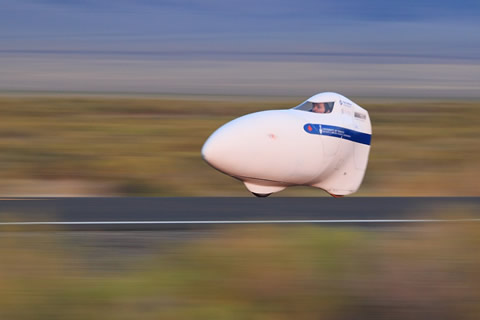How fast can a cyclist go? A team of U of T engineering students is testing the limits with a two-wheeled vehicle that they designed and built themselves.
At a race last fall, Todd Reichert – a PhD student and one of the team’s four drivers – reached a top speed of 116.9 km/h using only his legs for power. The result lifted the U of T group to a third-place finish in the World Human-Powered Speed Challenge in Battle Mountain, Nevada. The event, held annually, draws about a dozen teams from North America and Europe.
Sponsored by the International Human-Powered Vehicle Association, the challenge’s larger goal is to demonstrate sustainable transportation alternatives. The speed competition is one of several human-powered vehicle contests held each year. In others, the teams must design vehicles that consider the needs of real-world drivers – commuters, for example, or shoppers who might need space for groceries.
Aidan Muller, a second-year student in materials science and engineering, says superb aerodynamic design is critical to succeeding in the speed competition. In the run-up to the race, the team computer-tested several designs, and ended up with a carbon-fibre shell that looks remarkably like the nose of an airplane. Then they treated the shell’s surface, especially the front, to make it as smooth as possible. “Up to 80 per cent of the force you use is to cut into drag. Even minor flaws can slow you down,” says Muller. Weight is also an issue, so the team conducted a lot of research into materials. This year’s vehicle tipped the scales at 27 kg, but the team aims to reduce that by a third or even half.
For four of the team members, the real excitement comes on race day. Muller and the other drivers each take turns lowering themselves inside the vehicle, sitting in a recumbent position and checking the equipment one last time. Their exact position within the vehicle has been tested and retested; clearances are adjusted by millimetres. They’ve undergone weeks of physical training in preparation for this moment. Guided to a rolling start, the drivers have to steer carefully to keep the vehicle steady until they are able to pick up speed over the eight-kilometre race.
Muller, an avid cyclist, says his experience on the team has allowed him to meld his personal and professional interests. It’s also a great way to use the knowledge he learns in the classroom. “You don’t really feel like you’re a real engineer until you apply what you’ve learned,” he notes. And how does it feel to rocket along at a self-powered speed of more than 100 km/h? “It’s exhilarating!”
Watch a video of the team in action.
Recent Posts
U of T’s Feminist Sports Club Is Here to Bend the Rules
The group invites non-athletes to try their hand at games like dodgeball and basketball in a fun – and distinctly supportive – atmosphere
From Mental Health Studies to Michelin Guide
U of T Scarborough alum Ambica Jain’s unexpected path to restaurant success
A Blueprint for Global Prosperity
Researchers across U of T are banding together to help the United Nations meet its 17 sustainable development goals






